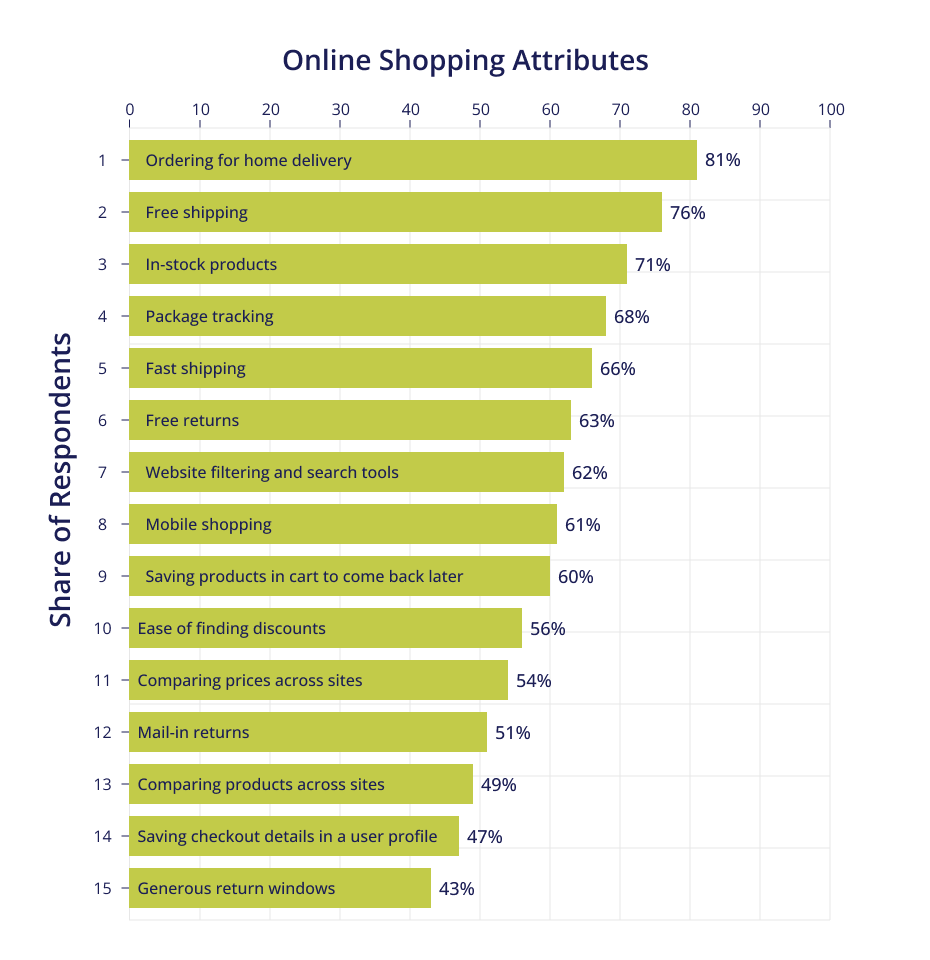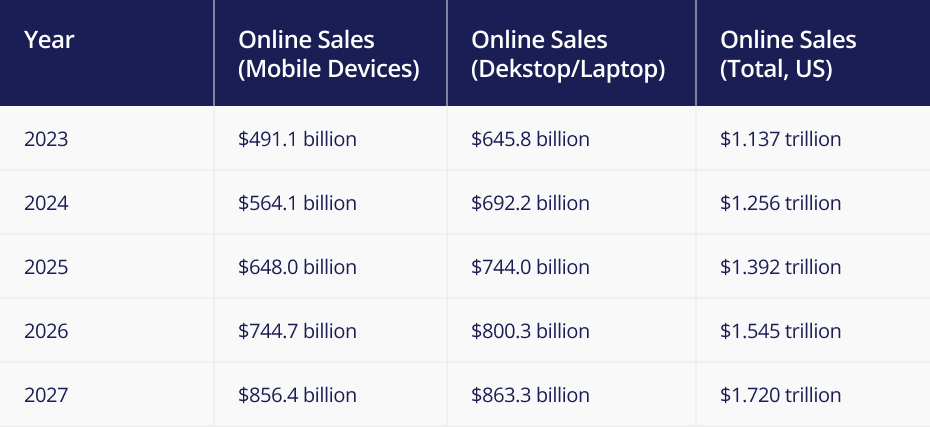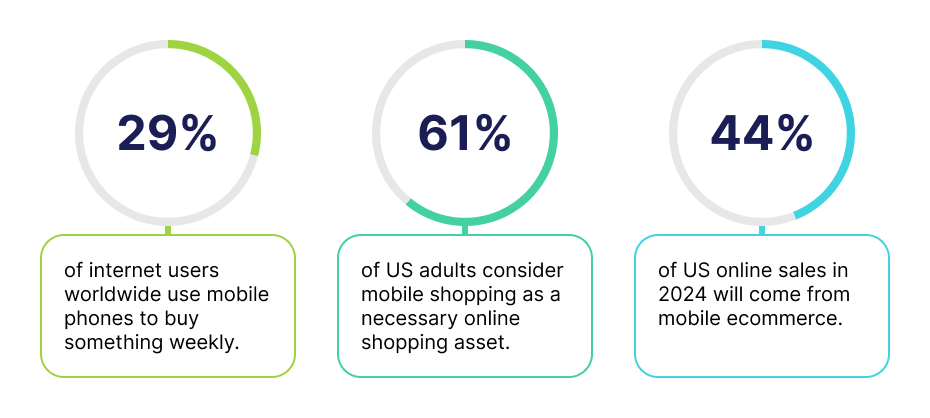The retail landscape is expediting in terms of ecommerce sales, making it 20.1% of online sales. This implies how the businesses are attuning their models with virtually existing and restructuring their overall revenue growth. To say that online shopping has revolutionized the industry is an understatement. Considering that convenience is a priority to all, making it a user preference, businesses are upscaling their solutions with ecommerce development trends.
Since the premise of user experience enhancement brings the decision-makers closer to trends that are modifying the business models, it is preferred to familiarize with the technology firsthand. For instance, AI is among the transformational innovations assisting in automating. However, the apprehension of features and functionalities linked to the businesses becomes imperative.
That being said, for decision-makers like you in the ecommerce sector, it is preferred to evaluate the best technology based on your needs. To assist you with that, we have brought forth the ecommerce trends for 2025 that pose benefits worth investment.
Market Overview with Ecommerce Growth Trends and Statistics
Prior to beginning with the ecommerce technology trends, apprehending the market value and user behaviour is necessary. Since conclusions can be drawn with ease, figures often bring forth a realistic view of the market.
As per the reports, 81% of users prefer home delivery, 71% go for in-stock products, 68% look for package tracking, and 61% opt for mobile shopping. These figures represent the convenience-centred experience that users go for when shopping online. To say that this behavior-focused statistics brings an idea that users are assessing the perks ecommerce businesses are offering them and make decisions as per that.

In 2024, $1.13 Tn of total online sales was recorded, with $564 Bn from mobile devices and $692 Bn from desktop and laptops. To say that being digitally presents and optimizing the business persona the users becomes must. Catering to both brings sum total of amount that is expected to reach the $1.72 Tn by 2027.

These statistics emphasize the fact that ecommerce digital transformation is a must in a landscape where business-based solutions have pertinence in bringing in users and augmenting conversions. Thus ultimately driving tangible business results and revenues.
Emerging Top 10 Ecommerce Development Trends for 2025
Considering that the market value is comprehended, the inclination towards the ecommerce development trends becomes imperative to assess. To modify the solutions or build new ones becomes a choice in context to upgrade the customer experience. While industry-wide businesses need diverse integrations and solutions, the below trends can be aligned based on preference.
-
Artificial Intelligence in eCommerce
Artificial intellgence, involving multiple subsets like ML, NLP, and LLM, is an inventive technology changing the face of businesses with automation. Assessing large datasets, recognizing patterns, and bringing in results and predictions are functionalities that are attuning workflow pace, mitigating risks, identifying frauds, and recommending user products that match their needs.
While this is in place to modify the experience, Amazon, the biggest global ecommerce business, introduced Rufus, an LLM-based chatbot assisting businesses in answering questions related to the product. Not only this, the ecommerce tycoon is not staying limited to chatbots but will be presenting the world with an AI agent smart enough to order products that fall under your monthly needs without having to ask.
In another use case, the AI in ecommerce has been utilized by Pinterest to recognize the image and bring the product matching it. We are not talking about similar products here; the results are exact matches.

-
mCommerce App Development
Mobile commerce, popularly known as mCommerce, is modernizing the future of online retail by bringing entire storefronts to users’ pockets. From in-app purchases to mobile-first UX strategies, mCommerce is no longer a trend but a business mandate that businesses are opting for to boost their revenues. Mobile apps now act as personalized stores, where smooth navigation, real-time push notifications, native payment gateways, and biometric logins redefine convenience and speed.

With smartphones being an extension of the consumer, brands are embracing mCommerce to scale up higher engagement and conversion funnels enhancement. Take Nike, for instance. Its mobile app is not just a digital store but a deeply personalized shopping companion. Through geolocation, app-exclusive drops, and customized recommendations, Nike connects with users one-to-one, resulting in higher retention and sales uplift.
Meanwhile, Shein, the fast-fashion ecommerce giant, has taken mCommerce even further. Its mobile app integrates gamification, flash sales, and AI-driven personalization to create a high-frequency engagement loop. With users spending hours on the app, browsing, playing spin-the-wheel deals, or checking daily tasks, Shein demonstrates how mCommerce can be more than a transaction point; it can be a habit.
While brands like these innovate, mCommerce is pushing boundaries to include AR try-ons, voice-based search, and frictionless one-click checkouts. It’s not just about optimizing for mobile anymore; it’s about designing for mobile-first behavior, making the experience feel native, dynamic, and intuitive at every step.
-
Voice Commerce
Voice commerce, an overlapping of AI and consumer convenience, is restructuring users’ interactions with eCommerce platforms using voice commands. Powered by technologies like Natural Language Processing (NLP), Automatic Speech Recognition (ASR), and voice-based AI engines, voice commerce allows users to search, shop, and order just by speaking. It’s frictionless, fast, and increasingly becoming the preferred mode of interaction, especially for on-the-go consumers.
The beauty of voice commerce lies in its hands-free efficiency. From reordering household essentials to asking about deals or getting delivery updates, voice-driven interfaces augment the customer experience by eliminating traditional barriers like typing or navigating through endless menus.
Walmart, a retail giant, teamed up with Google to offer Walmart Voice Order, allowing customers to add items to their carts just by speaking to Google Assistant. Whether you’re cooking and realize you’re out of milk or need to reorder your usual snacks, Walmart makes it possible with a simple “Hey Google, add eggs to my Walmart cart.” The AI behind the feature even remembers your past orders, so you get the exact brand and size you usually prefer.

Voice commerce is no longer experimental, it’s experiential for the users. And as voice assistants become smarter and more embedded in daily life, eCommerce brands tapping into this channel are not just selling, they’re speaking their customers’ language.
-
Progressive Web Apps (PWA)
Progressive Web Apps are modern digital storefronts that combine the best of web and mobile into a single lightweight experience. Fast, responsive, offline-capable, and installable, PWAs enable eCommerce brands to drive tangible customer experiences without the overhead of native apps. From reduced bounce rates to faster load speeds and app-like interfaces, PWAs are known to uplift user engagement and conversions, especially in regions where low bandwidth is a concern.
While this is in place to modify the experience, AliExpress, the global retail marketplace owned by Alibaba, rebuilt its mobile site into a PWA and witnessed a 104% increase in conversion rates for new users and a 2x increase in pages visited per session. The PWA was faster, lighter, and more responsive, even on flaky connections.
Likewise, Flipkart, India’s largest online retailer, rolled out Flipkart Lite, a PWA version of its platform, to tackle performance issues and data constraints in emerging markets. The results were clear: 40% higher re-engagement and significantly reduced data usage, proving that PWAs are not just a tech trend but a strategic move toward mobile commerce dominance.
-
Augmented Reality in Ecommerce
From virtually placing furniture in your living room to trying on glasses before purchasing, augmented reality is bridging the gap between digital browsing and in-store experiences. These immersive technology tools are augmenting visualization, diminishing return rates, and bringing a layer of interactivity that’s attuning customer satisfaction.
As a leader in furniture retail, IKEA has tapped into the potential of AR through its IKEA Place app. The app allows users to virtually “place” true-to-scale 3D models of furniture in their home environment using their smartphone camera. The goal is simple yet powerful—help customers make confident decisions by seeing exactly how the product fits and looks in real space, all before hitting ‘Buy Now’.

On a different front, L’Oréal took the virtual route with its ModiFace technology. Designed for beauty brands, ModiFace uses AR to allow shoppers to try on makeup products- lipsticks, foundations, and eyeshadows- directly on their face in real time. This has not only improved the product discovery experience but also drastically increased consumer confidence, especially in a category where physical trial is often key to purchase.

AR in eCommerce isn’t just about novelty. It’s about creating intuitive and confidence-boosting experiences that mimic the tangibility of offline retail while maintaining the ease of digital.
-
Blockchain Technology
Blockchain Technology, rooted in the principles of transparency, security, and decentralization, is reshaping the digital marketplace by removing intermediaries, building trust, and creating tamper-proof transaction records. In the ecommerce space, it’s not just a buzzword. It’s a real-time solution that enhances traceability, prevents fraud, and improves operational efficiencies by verifying product origin, delivery, and payment authenticity.
One of the most prominent examples is Alibaba’s use of blockchain for food traceability through its AntChain platform. In collaboration with local authorities and supply chain partners, Alibaba ensures that food items, from origin to shelf, are securely recorded and traceable in real time. This adds a layer of trust for customers, especially when it comes to perishables and imported goods.

As this technology matures, blockchain is becoming more than just a back-end innovation. It’s building consumer trust, ensuring authenticity, and creating a smarter, more secure shopping ecosystem where data can’t be faked and transparency is the new standard.
-
Hyperpersonalization
Hyperpersonalization, powered by real-time data, behavioral analytics, and AI algorithms, is redefining how customers interact with ecommerce platforms. By analyzing individual user preferences, browsing history, location, and purchasing habits, businesses are now able to create uniquely tailored shopping experiences, not just segment-based suggestions, but one-to-one personalization that adapts in real time.
This trend goes far beyond addressing customers by their names or showing related products. It’s about predicting intent, anticipating needs, and delivering micro-level experiences across touchpoints, from homepage banners and product listings to emails and push notifications.
A prime example comes from Sephora, the global beauty retailer. Their hyperpersonalization strategy includes AI-powered skin diagnostics and shade-matching tools that personalize product recommendations through Virtual Artist. Beyond that, their app integrates loyalty data and browsing behavior to dynamically update promotions and content specific to each user, creating a seamless omnichannel experience whether customers are online or in-store.
In another approach, eBay has adopted Netflix-style personalization. By leveraging deep user data and machine learning, eBay curates homepage feeds and promotions tailored to a user’s past purchases, categories of interest, and even price range preferences. The result? An eCommerce experience that feels less like a catalog and more like a personal shopping assistant who understands your habits, timing, and style.
Hyperpersonalization isn’t just a trend but a shift in consumer expectation. And for brands looking to foster loyalty and increase conversions, it’s quickly becoming the standard.
-
Headless and Composable Commerce
Headless and composable commerce is transforming the traditional way digital storefronts function by decoupling the front-end and back-end layers of eCommerce platforms. This architectural shift is giving businesses greater flexibility in delivering seamless, high-performing, and personalized experiences across channels like web, mobile, smart devices, and beyond. The composable nature further enhances it by allowing enterprises to pick and integrate best-of-breed solutions into their tech stack based on specific business needs.
Instead of relying on a one-size-fits-all monolithic system, brands are now leveraging microservices and APIs to independently manage components like search, checkout, payments, and CMS. This modular approach significantly accelerates development cycles, reduces time-to-market, and enables rapid testing and innovation.
One of the strongest examples of this trend is Coca-Cola, which leveraged composable commerce to launch new D2C (direct-to-consumer) initiatives. Instead of building from scratch, they composed a flexible digital ecosystem using best-fit services like content, loyalty, and payment tools. This approach allowed them to roll out localized and seasonal campaigns while scaling across markets with minimal friction.
With scalability, customization, and agility at its core, headless and composable commerce is not just a trend; it’s a strategic enabler that allows global businesses to stay relevant, reactive, and resilient in today’s highly dynamic digital market.
-
Social Commerce Integration
Social commerce integration is an ecommerce trend that redefines brands’ connection with buyers, blending product discovery, engagement, and conversion into a seamless experience within social platforms. By turning likes, shares, and comments into direct sales opportunities, this fusion of eCommerce and social media is not just about presence anymore — it’s about performance. Customers buy where they scroll, making decisions on the fly with contextual trust built through creators, communities, and conversation.
Tapping into this, TikTok Shop has emerged as a frontrunner, embedding a native shopping experience directly into the For You feed. Influencers can now tag products in videos, live sessions, or even in the comments, taking a viewer from discovery to checkout without leaving the app. This isn’t limited to just product links; it’s a fully immersive commerce journey powered by social behavior.

Taking a different route, Instagram Checkout enables brands to build curated storefronts within their profiles while allowing users to browse, save, and purchase, all without a single redirect. Combined with shoppable Reels and Stories, it offers a contextualized, mobile-first storefront where content and commerce are no longer separate.
With Gen Z and Millennials leading mobile-first discovery, social commerce is transforming passive scrolling into active shopping. It’s not just about selling on social media but about selling because of social media.
-
Multiple Payment Gateway and Collection Options
Digital commerce is incomplete without frictionless transactions, and that’s where the evolution of payment gateways plays a pivotal role. Enabling users to choose how they pay, be it through wallets, BNPL, credit cards, or even cryptocurrencies, is not just a convenience anymore. It’s a competitive necessity. The rise of smart checkout systems, regional payment integrations, and flexible collection models is actively shaping how brands maximize conversions and build trust.
In this ever-expanding space, Shopify, one of the largest global eCommerce platforms, introduced Shopify Payments, eliminating third-party gateway dependencies while offering a seamless way to manage multi-channel payments under one roof. Integrated with local methods like iDEAL in the Netherlands or Klarna in Europe, the system is more than just a gateway, it’s a collection ecosystem tailored to location and user behavior.
On the other side of the innovation spectrum, Razorpay, an Indian fintech powerhouse, empowers small and mid-sized businesses with diverse collection options. From enabling UPI, NEFT, wallets, and even EMIs to providing custom checkout pages and real-time analytics, Razorpay is redefining accessibility. The smart routing system ensures the best success rate by automatically switching gateways in case of downtime, a major win for cart conversions.
As consumer expectations shift towards speed, security, and personalization, the ability to offer multiple gateways and localized collections isn’t just enhancing customer experience (CX), it’s driving retention, reducing bounce rates, and unlocking global scalability.
For More Details: Payment Gateway Integration in eCommerce – A Quick Guide
How to Choose the Right Ecommerce Technology Trends for Brand Augmentation?
Considering that all these ecommerce trends are among the choices that businesses are opting to modernize, it is time to find out how to choose the right technology to match your brand’s needs. It is not like you decide on integrating a technology and get results. The process requires an approach that is data-driven and decides upon evaluating the existing issues and insights. To find out the step-by-step, take a thorough read on the segment mentioned below.
-
Assess and Evaluate Your Business Goals
As we mentioned above, you have to evaluate the business goals, the upcoming revenue-focused targets, and the audience you want to target. This way, you get a direction towards the need for either integrating new models or modifying the existing ones.
-
Analyze the Business’s Current Digital Maturity
Now that the goal is clear, it is time to assess the position of brands in terms of statistics, foundational system existence, and system security. This way, you choose ecommerce technology trends that build on your current stack rather than forcing a complete overhaul.
-
Evaluate Trends Based on Relevanve, Not Popularity
It becomes imperative to evaluate the trends based on relevance and need, rather than going for popularity. The influence is understandable, but what your system requires is also essential. Here’s how to break it down:
| Trend | Best for Brands That |
| AI & Predictive Analytics | Want to personalize CX, improve recommendations, or forecast demand |
| AR/VR | Sell tactile/visual products (fashion, furniture, cosmetics) |
| Headless Commerce | Need omnichannel consistency and scalability |
| Blockchain | Focus on transparency, supply chain integrity, or loyalty |
| mCommerce | Target mobile-first or Gen Z customers |
| Voice Commerce | Cater to accessibility and convenience seekers |
| PWAs | Want app-like experiences without building native apps |
-
Partner With a Custom Ecommerce Development Company
When the time comes to implement the necessary ecommerce development trends, you must take assistance from a leading ecommerce development company. Considering they have valuable insights towards industry-wide changes, they can also provide you with integration options and build an intelligent solution from scratch.
-
Get on With Custom Ecommerce Web Development
Once the service provider is finalized, the end-to-end ecommerce web and app development begins, keeping the UI/UX design, development, testing, deployment, and maintenance in mind. This phase provides the businesses with the necessary features, models, and functionalities and converts them into intelligent solutions.
-
Test, Measure, and Iterate Bring Change
Once the solution is deployed and catered to the audience, the task of understanding the performance begins. During this phase, you comprehend how the audience is perceiving the solution, feature, or functionality and iterate based on the statistics to augment the performance.
Why Choose SparxIT as Your Trusted Ecommerce Website Development Company?
As the understanding of these ecommerce technology trends is essential, it comes to the stage where the assistance of a service provider with decade-long proficiency becomes imperative. In such cases, we at SparxIT offer our clients industry-wide insights into intelligent technologies and modify the business model.

Partner with Experts
Frequently Asked Questions
Which ecommerce trends are expected to dominate in 2025?






In 2025, expect AI personalization, voice and social commerce, blockchain payments, AR/VR product previews, and headless commerce to take center stage, shaping faster, smarter, and more engaging shopping experiences.
Is making ecommerce more accessible essential for future growth?










How can I evaluate whether a trend adoption is paying off?










What are the signs that a trend isn’t right for my business?












